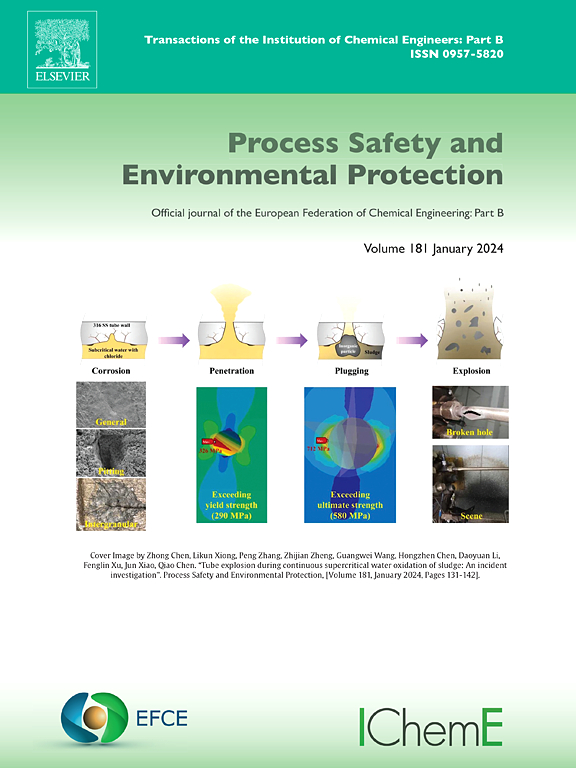Resilience-based design of barrier system to mitigate fire-driven escalation in process plants
IF 6.9
2区 环境科学与生态学
Q1 ENGINEERING, CHEMICAL
引用次数: 0
Abstract
Fire-driven escalation is a typical type of domino effect, which may lead to severe consequences in process plants. A barrier system comprising by add-on barriers and procedural barriers could effectively mitigate fire-driven escalation, but its optimization poses great challenges to safety managers. In this paper, a resilience-based methodology is proposed to identify the optimal design scheme of barrier system considering the cost-effectiveness. Possible schemes of barrier system under a limited budget and their effects are explored. Dynamic Bayesian network is used to model the evolution patterns of fire escalation, while the dynamic uncertainties associated with accident evolution are quantified. Resilience, a metric that could capture the dynamic change of plant performance in the accident and recovery period, is employed and quantified to determine the barrier system with highest profit on fire-driven escalation mitigation. A case study of a tank farm is applied to illustrate the applicability of the proposed methodology, in which different design schemes of barrier systems for increasing resilience are discussed and some recommendations are given. The developed methodology directly associates safety budget with plant resilience, which could help safety managers and decision-makers of new or existing chemical plants identify the optimal scheme of barrier allocation addressing fire-driven escalations.
基于弹性的屏障系统设计,以减轻工艺工厂中火灾驱动的升级
火灾驱动的升级是一种典型的多米诺骨牌效应,它可能导致加工工厂的严重后果。由附加屏障和程序屏障组成的屏障系统可以有效地缓解火灾升级,但其优化给安全管理人员带来了很大的挑战。本文提出了一种基于弹性的方法,以确定考虑成本效益的屏障系统的最优设计方案。在有限的预算条件下,探讨了屏障系统的可能方案及其效果。采用动态贝叶斯网络对火灾升级的演化模式进行建模,量化了与事故演化相关的动态不确定性。弹性是一种度量,可以捕捉事故和恢复期间工厂性能的动态变化,采用并量化以确定在火灾驱动的升级缓解中利润最高的屏障系统。本文以某油库为例,讨论了提高弹性的不同屏障系统设计方案,并提出了一些建议。所开发的方法直接将安全预算与工厂恢复力联系起来,这可以帮助新建或现有化工厂的安全管理人员和决策者确定解决火灾驱动升级的最佳屏障分配方案。
本文章由计算机程序翻译,如有差异,请以英文原文为准。
求助全文
约1分钟内获得全文
求助全文
来源期刊

Process Safety and Environmental Protection
环境科学-工程:化工
CiteScore
11.40
自引率
15.40%
发文量
929
审稿时长
8.0 months
期刊介绍:
The Process Safety and Environmental Protection (PSEP) journal is a leading international publication that focuses on the publication of high-quality, original research papers in the field of engineering, specifically those related to the safety of industrial processes and environmental protection. The journal encourages submissions that present new developments in safety and environmental aspects, particularly those that show how research findings can be applied in process engineering design and practice.
PSEP is particularly interested in research that brings fresh perspectives to established engineering principles, identifies unsolved problems, or suggests directions for future research. The journal also values contributions that push the boundaries of traditional engineering and welcomes multidisciplinary papers.
PSEP's articles are abstracted and indexed by a range of databases and services, which helps to ensure that the journal's research is accessible and recognized in the academic and professional communities. These databases include ANTE, Chemical Abstracts, Chemical Hazards in Industry, Current Contents, Elsevier Engineering Information database, Pascal Francis, Web of Science, Scopus, Engineering Information Database EnCompass LIT (Elsevier), and INSPEC. This wide coverage facilitates the dissemination of the journal's content to a global audience interested in process safety and environmental engineering.
 求助内容:
求助内容: 应助结果提醒方式:
应助结果提醒方式:


